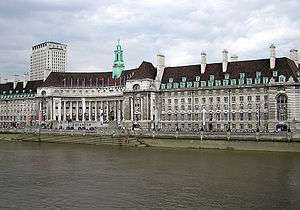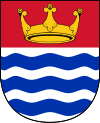Greater London Council
| Greater London Council | |
|---|---|
|
Coat of arms | |
|
Flag | |
| Type | |
| Type | |
| History | |
| Established | 1 April 1965 |
| Disbanded | 31 March 1986 |
| Preceded by | London County Council |
| Succeeded by |
Inner London Education Authority London Boroughs Grants Committee London Fire and Civil Defence Authority London Planning Advisory Committee London Regional Transport London Research Centre and various others |
| Seats |
100 (1965–1973) 92 (1973–1986) |
| Elections | |
Last election | 1981 |
| Meeting place | |
 | |
| County Hall, Lambeth | |
The Greater London Council (GLC) was the top-tier local government administrative body for Greater London from 1965 to 1986. It replaced the earlier London County Council (LCC) which had covered a much smaller area. The GLC was dissolved in 1986 by the Local Government Act 1985 and its powers were devolved to the London boroughs and other entities. A new legislative body, known as the Greater London Authority (GLA), was established in the year 2000.
Creation
The GLC was established by the London Government Act 1963, which sought to create a new body covering all of London rather than just the inner part of the conurbation, additionally including and empowering newly created London boroughs within the overall administrative structure.
In 1957 a Royal Commission on Local Government in Greater London had been set up under Sir Edwin Herbert, and this reported in 1960, recommending the creation of 52 new London boroughs as the basis for local government. It further recommended that the LCC be replaced by a weaker strategic authority, with responsibility for public transport, road schemes, housing development and regeneration. Most of the Commission’s recommendations were accepted, but the number of new boroughs was reduced to 32. Greater London covered the whole County of London and most of Middlesex, plus parts of Essex, Kent and Surrey, a small part of Hertfordshire and the County Boroughs of Croydon (Surrey) and East and West Ham (both in Essex), all of which had been independent of county council control since 1889.
Some areas on the boundaries of the area recommended by the Herbert Commission, fearing increased local taxation, fought successfully not to come under the new Greater London Council, notably the urban districts of Chigwell in Essex; and Sunbury-on-Thames, Staines and Potters Bar in Middlesex. Other areas recommended for inclusion that were never part of Greater London included Epsom and Ewell, Caterham and Warlingham, Esher, and Weybridge.
GLC councillors elected for areas within the former County of London became ex officio members of the new Inner London Education Authority, which took over the LCC responsibility for education. By contrast in Outer London, which was the rest of Greater London, the various London boroughs each became a local education authority, akin to a county council or county borough in the rest of England.
Powers
The GLC was responsible for running strategic services such as the fire service, emergency planning, waste disposal and flood prevention. The GLC shared responsibility with the London boroughs for providing roads, housing, city planning and leisure services. It had a very limited role in direct service provision with most functions the responsibility of the London boroughs. The GLC did not take control of public transport from the London Transport Board until 1970 and lost control to London Regional Transport in 1984.
Under the 1963 Act, the GLC was required to produce a Greater London Development Plan. The plan included in its wide ranging remit: population changes, employment, housing, pollution, transport, roads, the central area, growth and development areas, urban open spaces and the urban landscape, public services and utilities and planning standards. The plan included the comprehensive redevelopment of Covent Garden and creating a central London motorway loop. The plan was subject to an Inquiry which lasted from July 1970 until May 1972.[1] The campaign to save Covent Garden along with various opposition on other matters largely derailed the plan.
Composition and political control

Each of the six GLC elections was won by the leading national opposition party, with the party in government nationally coming second in the GLC elections.
The first GLC election was on 9 April 1964. Each of the new boroughs elected a number of representatives under the bloc vote system. Despite Conservative hopes, the first GLC consisted of 64 Labour and 36 Conservative councillors and Labour Group leader Bill Fiske became the first Leader of the Council.
At the next election in 1967 the unpopularity of the national Labour government produced a massive Conservative victory with 82 seats, to Labour's 18. Desmond Plummer became the first Conservative leader of London-wide government in 33 years. The Conservatives retained control in 1970 with a reduced majority.
In 1972 the electoral system was reformed to introduce single-member constituencies for the election after the 1973 contest, and extend the term of office to four years. Labour fought the 1973 election on a strongly socialist platform and won with 57 seats to 33 for the Conservatives. The Liberals won two seats.
The GLC's hopes under the Labour administration of Reg Goodwin were badly affected by the oil crisis of 1974. Massive inflation which when combined with the GLC's £1.6 billion debt led to heavy rate increases (200% in total before the next election in 1977) and unpopular budget cuts. Some months before the 1977 elections the Labour Group began to split. A left group, including Ken Livingstone, denounced the election manifesto of the party.
The Conservatives regained control in May 1977, winning 64 seats under their new Thatcherite leader Horace Cutler against a Labour total of just 28. Cutler headed a resolutely right-wing administration, cutting spending, selling council housing and deprioritising London Transport. In opposition the Labour party continued to fractionalise: Goodwin resigned suddenly in 1980 and in the following leadership contest the little-regarded left-winger Ken Livingstone was only just beaten in an intensely tactical campaign by the moderate Andrew McIntosh. However the Labour left were strong at constituency level and as the 1981 election approached they worked to ensure that their members were selected to stand and that their ideologies shaped the manifesto. The eventual manifesto topped out at over 50,000 words.
The May 1981 election was presented as a clash of ideologies by the Conservatives – Thatcherism against a 'tax high, spend high' Marxist Labour group, claiming that Andrew McIntosh would be deposed by Ken Livingstone after the election. McIntosh and Labour Party leader Michael Foot insisted this was untrue, and Labour won a very narrow victory with a majority of six. At a pre-arranged meeting of the new Councillors the day after the election, the Left faction won a complete victory over the less-organised Labour right. McIntosh lost with 20 votes to 30 for Ken Livingstone. Livingstone, dubbed 'Red Ken' by some newspapers, managed to gain the guarded support of the Labour deputy leader Illtyd Harrington and the party Chief Whip and set about his new administration.
Livingstone was able to push through the majority of his policies. The increased spending of the council led the national government to reduce and eventually end the GLC's central government grant as punishment.
Elections to the GLC
| Overall control | Conservative | Labour | Liberal | |
| 1981 | Labour | 41 | 50 | 1 |
| 1977 | Conservative | 64 | 28 | – |
| 1973 | Labour | 32 | 58 | 2 |
| 1970 | Conservative | 65 | 35 | – |
| 1967 | Conservative | 82 | 18 | – |
| 1964 | Labour | 36 | 64 | – |
Abolition
Livingstone’s high-spend socialist policies put the GLC into direct conflict with Margaret Thatcher’s Conservative government. Livingstone soon became a thorn in the side of the sitting Conservative government. He deliberately antagonised Thatcher through a series of actions (including posting a billboard of London’s rising unemployment figures on the side of County Hall, directly opposite Parliament); a Fares Fair policy of reducing Tube and bus fares using government subsidies; meeting Sinn Féin MP Gerry Adams at a time when Adams was banned from entering Britain due to his links with the Provisional IRA; and endorsing a statue of Nelson Mandela.
By 1983, the government argued for the abolition of the GLC, claiming that it was inefficient and unnecessary, and that its functions could be carried out more efficiently by the boroughs. The arguments for this case which were detailed in the White Paper Streamlining the cities. Critics of this position argued that the GLC’s abolition (as with that of the Metropolitan County Councils) was politically motivated, claiming that it had become a powerful vehicle for opposition to Margaret Thatcher’s government. Ken Livingstone and 3 other Labour councillors resigned in protest, and won back their seats easily in the September 1984 by-elections because the Conservatives refused to stand.[2]
The Local Government Act 1985, which abolished the GLC, faced considerable opposition from many quarters but was narrowly passed in Parliament, setting the end of the council for 31 March 1986. It also cancelled the scheduled May 1985 elections. GLC assets were assigned to the London Residuary Body for disposal, including County Hall, which was sold to a Japanese entertainment company and now houses the London Aquarium and the London Dungeon, amongst other things.
The Inner London Education Authority (ILEA) continued in existence for a few years, and direct elections to it were held, but ILEA was finally also disbanded in 1990, with the Inner London Boroughs assuming control over education as the Outer boroughs had done on their creation in 1965.
Replacement
Most of the powers of the GLC were devolved to the London boroughs. Some powers, such as the fire service, were taken over by joint boards made up of councillors appointed by the boroughs – see waste authorities in Greater London for an example. In total, around 100 organisations were responsible for service delivery in Greater London.[3]
Tony Blair's Labour government was elected in 1997, and was committed to bringing back London-wide government. In 1999 a referendum was held on the establishment of a new London authority and elected mayor, which was approved by a two to one margin.
The new Greater London Authority (GLA) was established in 2000. The GLA has a very different structure to the GLC, consisting of a directly elected Mayor of London and a London Assembly. The Mayor of London elections were won by the same Ken Livingstone, who began his victory speech with the words: "As I was saying before I was so rudely interrupted 14 years ago …".[4]
The archives of the Greater London Council are held at London Metropolitan Archives.
Leaders of the GLC
| Number | Image | Leader | Term | Party |
|---|---|---|---|---|
| 1 |  |
Bill Fiske (1905–1975) |
1964–1967 | Labour |
| 2 |  |
Desmond Plummer (1914–2009) |
1967–1973 | Conservative |
| 3 |  |
Sir Reginald Goodwin (1908–1986) |
1973–1977 | Labour |
| 4 |  |
Sir Horace Cutler (1912–1997) |
1977–1981 | Conservative |
| 5 | .jpg) |
Ken Livingstone (born 1945) |
1981–1986 | Labour |
See also
| Wikimedia Commons has media related to Greater London Council. |
- List of electoral divisions in Greater London
- List of Greater London Council committee chairs
- Members of the Greater London Council
- OXO Tower – controversially sold by the GLC for £750,000 to Coin Street Community Builders in 1984
- GLC: The Carnage Continues... – satire of the GLC politics by The Comic Strip
- Gay Rights Working Party – part of the Greater London Council
References
- ↑ Greater London Development Plan: Report of the panel of inquiry. HMSO. 1973. ISBN 0117506168.
- ↑ Rallings, Colin; Thrasher, Michael (1997). Local Elections in Britain. London: Routledge. p. 172. ISBN 9780203412756.
- ↑ Atkinson, H. & Wilks-Heeg, S., Local Government from Thatcher to Blair: The Politics of Creative Autonomy, 2000
- ↑ Waugh, Paul; Grice, Andrew (5 May 2000). "Ken reclaims the capital". The Independent.

